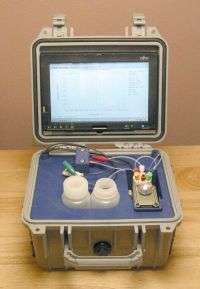New sensor system improves detection of lead, heavy metals

The Department of Energy’s Pacific Northwest National Laboratory has developed a new rapid, portable and inexpensive detection system that identifies personal exposures to toxic lead and other dangerous heavy metals. The device can provide an accurate blood sample measurement from a simple finger prick, which is particularly important when sampling children.
PNNL’s portable analyzer system accurately detects lead and other toxic metals in blood as well as in urine and saliva. Results are as reliable as those of current state-of-the-art mass spectrometry systems many times its size. This new system provides a quicker, simpler and easier method of monitoring toxic metal exposures in high-risk populations, such as industrial workers, children and people living in polluted areas.
A bit larger than a lunchbox, the new detection system is field-deployable with plug-and-play features that allow different sensors to be easily exchanged to detect a variety of heavy metal toxins. The entire system is battery-operated and requires about one and one-half times the power of a typical laptop computer. The system also routinely delivers reliable measurements within a rapid two-to-five minute analysis period.
Early production cost estimates indicate that the device may be as much as 10 times less expensive than existing plasma mass spectrometry systems, which lack field portability and require samples to be returned to the lab for time-consuming and more expensive analysis.
Accumulation of lead in children can harm the developing brain, causing reduced IQ, learning disabilities and behavioral problems, among other things. The Centers for Disease Control and Prevention report that about 310,000 U.S. children ages 1 to 5 have high levels of lead in their blood. Recent studies also indicate a link between lead exposure and a decline in mental ability many years later.
Recent attention to children’s exposure to lead from toys and products from the Far East has heightened the interest in toxic exposures to heavy metals. The ability to quickly and accurately identify children with elevated blood lead levels is important in providing treatment to those who need it. In addition, large numbers of industrial workers may be routinely exposed to toxic heavy metals like cadmium, lead and mercury, which are known to induce various diseases.
“We need next-generation analyzers to reduce the time and lower the costs of analysis for clinical diagnosis,” said PNNL scientist and principal investigator Wassana Yantasee. “They will help us better understand the relationship between the exposure to these toxins and how the body responds, which will help in developing new strategies to reduce exposures and risks.”
“Our research has focused on optimizing the sensor systems to work with the biological complexities in blood, urine and saliva samples,” said Yantasee. “Validation of these sensor platforms for use in biomonitoring is particularly important in developing a personalized exposure assessment strategy.”
The device can use two classes of sensors for detecting lead and other heavy metals. The first is based on a flow injection system using a mercury-film electrode to analyze metals in blood, urine or saliva samples.
To eliminate the use of toxic mercury in conducting the analysis, the second class of the sensor uses a mercury-free approach of nanostructure materials developed at PNNL. This involves use of either Self-Assembled Monolayers on Mesoporous Supports – SAMMS™ technology - or functionalized magnetic nanoparticles that provide excellent detection sensitivity at a parts-per-billion level.
Source: Pacific Northwest National Laboratory















